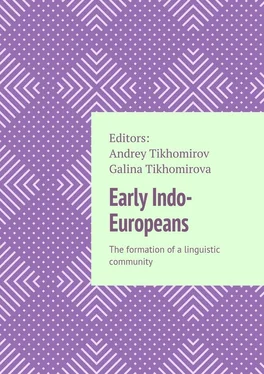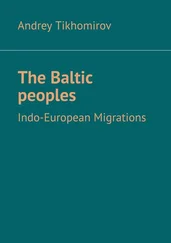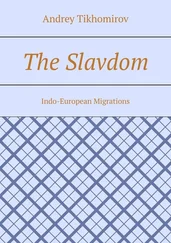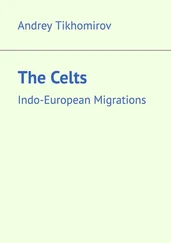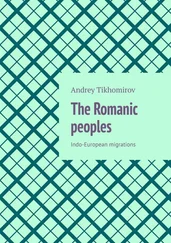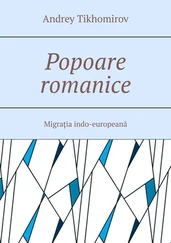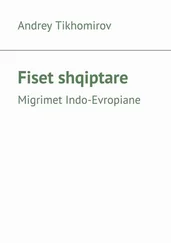Andrey Tikhomirov - Early Indo-Europeans. The formation of a linguistic community
Здесь есть возможность читать онлайн «Andrey Tikhomirov - Early Indo-Europeans. The formation of a linguistic community» — ознакомительный отрывок электронной книги совершенно бесплатно, а после прочтения отрывка купить полную версию. В некоторых случаях можно слушать аудио, скачать через торрент в формате fb2 и присутствует краткое содержание. ISBN: , Жанр: Биология, История, Языкознание, на английском языке. Описание произведения, (предисловие) а так же отзывы посетителей доступны на портале библиотеки ЛибКат.
- Название:Early Indo-Europeans. The formation of a linguistic community
- Автор:
- Жанр:
- Год:неизвестен
- ISBN:9785449082268
- Рейтинг книги:3 / 5. Голосов: 1
-
Избранное:Добавить в избранное
- Отзывы:
-
Ваша оценка:
- 60
- 1
- 2
- 3
- 4
- 5
Early Indo-Europeans. The formation of a linguistic community: краткое содержание, описание и аннотация
Предлагаем к чтению аннотацию, описание, краткое содержание или предисловие (зависит от того, что написал сам автор книги «Early Indo-Europeans. The formation of a linguistic community»). Если вы не нашли необходимую информацию о книге — напишите в комментариях, мы постараемся отыскать её.
Early Indo-Europeans. The formation of a linguistic community — читать онлайн ознакомительный отрывок
Ниже представлен текст книги, разбитый по страницам. Система сохранения места последней прочитанной страницы, позволяет с удобством читать онлайн бесплатно книгу «Early Indo-Europeans. The formation of a linguistic community», без необходимости каждый раз заново искать на чём Вы остановились. Поставьте закладку, и сможете в любой момент перейти на страницу, на которой закончили чтение.
Интервал:
Закладка:
Early Indo-Europeans
The formation of a linguistic community
Andrey Tikhomirov
Galina Tikhomirova
© Andrey Tikhomirov, 2018
© Galina Tikhomirova, 2018
ISBN 978-5-4490-8226-8
Created with Ridero smart publishing system
Introduction
Archaeological studies show that the native land of Indo-Europeans is the South Ural region, where they were formed as the united lingual group. The Indo-European languages are formed in the deep antiquity and originate from the earliest united Indo-Europeans language, whose carriers lived about 5—6 thousand years ago. In 1903, Keshav Gangadhar Tilak (1856 – 1920) wrote the book The Arctic Home in the Vedas. In it, he argued that the Vedas could only have been composed in the Arctics, and the Aryan (Indo-Europeans) bards brought them south after the onset of the last ice age. On the territory of the South Ural have been formed the most ancient beliefs, which became the basis of subsequent religions: Vedism and Mazdaism, which in turn evolved from primitive beliefs. Borrowing from each other and from previous beliefs, different views and ideas, created on the basis of specific conditions of human existence, such faiths: Vedism – Brahmanism – Hinduism in the sixth century BC there are Buddhism and Jainism as being in opposition to Brahmanism that sanctifies the caste system in India. Zoroastrianism – Mithraism in Iran (the word “Iran” comes from the word “Arian”, and it, in turn, to the word “Aria” – “ram”, in Latin “aries”, the ancient totem animal of the inhabitants of the southern Ural).
The pit grave culture is archaeological culture of the late copper age – early bronze age (3600—2300 BC). It occupied the territory from the southern Ural in the East to the Dniester in the West, from the Caucasus in the South to The middle Volga region in the North. The pit grave culture was predominantly nomadic, with elements of hoe agriculture near the rivers and some towns. Hoes under this were made from broken bones (horns). Yamniki created wheel carts (carts). The earliest finds in Eastern Europe are remnants of the four-wheeled carts burial ground tombs discovered in the burials of the Yamna culture (for example, “Guard the tomb” on the territory of Dnipropetrovsk in Ukraine, the burial ground in Odessa region (Ukraine), Chumaevskii burial ground in the Orenburg region, etc.). Metal raw material was obtained in the Caucasus. A characteristic feature of the pit culture is burying the dead in pits under the barrows in the supine position, with knees bent. Bodies fell down ochre. Burials in barrows were plural and often made at different times. Also found burial of animals (cows, pigs, sheep, goats and horses), which is typical for Indo-Europeans. Yamna culture originates from the Khvalynsk culture on the middle reaches of the Volga River and in the middle reaches of the Dnieper and its genetically associated with the funnel beaker culture. Yamna culture is replaced Poltavchenko. In the West Yamna culture is replaced by the catacomb culture. In the East – Andronovo and srubnaya (log house) culture. Within the framework of the early version of the Kurgan hypothesis of Marija Gimbutas, the yamnaya (pit grave) culture was associated with late proto-Indo-Europeans. According to her, the area of yamnaya culture was the territory of the spread of the pre-Indo-European language in the late European period, along with the earlier average culture. Currently, supporters of this version are very few, because glottochronology and the reconstructed proto-Indo-European vocabulary allow us to date the disintegration of proto-Indo-European community for several millennia earlier Yamna culture. In later versions of the Kurgan hypothesis, the population of yamnaya culture is associated with native speakers of Aryan languages (ancestors of Indo-Iranians, dardic and Nuristan languages). The Dardic languages (also Dardu or Pisaca) are a sub-group of the Indo-Aryan languages natively spoken in northern Pakistan’s Gilgit Baltistan and Khyber Pakhtunkhwa, northern India’s Jammu and Kashmir, and eastern Afghanistan. Anthropologically the population of pit-grave culture characteristic sharply Caucasoid features.
In the copper age (also – copper-stone age, Chalcolithic, Eneolithic) Europe are beginning actively populate carriers newcomers with the North cultures, brought with a horse, wheel and burial mounds burial. Within the framework of the Kurgan hypothesis, these cultures are associated with the earliest native speakers of Indo-European languages in Europe. The economy of the copper age, even in regions where copper was not used, no longer consisted of agricultural communities and tribes. There is a diversification of production: now a number of materials were produced in certain places, from where they spread to distant regions. In a number of places mine production of metal ores and a stone, along with creation from these materials of valuable goods developed. Starting from 3500 – 3000 BC, copper is used in the Balkans, Eastern and Central Europe. However much more important innovation this period is the emergence of horses and wheels, and associated with this raising mobility cultures. From 3500 onwards, representatives of cultures originating from the circumference (between the Black and Caspian seas) steppes, such as the yamnaya culture, begin to penetrate into Eastern Europe. There is a mixed complex, known as srednestogovskaya culture, which displaces the previous Dnieper-Donets culture, forcing its carriers to migrate in a North-westerly direction towards the Baltic, where they mingled with the local population (Arabelle), form the culture funnel beaker A and C. towards the end of the specified period on the lower Danube there is another branch of the mound cultures, the culture of Cernavoda I.
The Bronze Age is the epoch of human history, allocated on the basis of archaeology data, which is characterized by the leading role of bronze products, which was associated with the improvement of processing of metals such as copper and tin, obtained from ore deposits, and subsequent production of bronze. The Bronze Age is the second, late phase of the early metal replaced the copper age and preceded the iron age. In General, the chronological framework of the Bronze Age: 35/33—13/11 centuries BC, but they differ from different cultures. The Bronze Age on the territory of Europe followed the European copper age (Western archaeologists regarded as the final stage of neolith) at the end of III Millennium BC (late tradition of bell-shaped cups). In most parts of the European bronze age is almost completely covers the second Millennium BC, however, in the Eastern Mediterranean it ended with a bronze collapse, when almost all civilizations in the region from Greece to Mesopotamia died or fell into decline, while in Atlantic Europe there was a relatively smooth transition to the iron age, the onset of which was sometimes delayed until 600—500 BC.
South Ural may well be the birthplace of Indo-Europeans. This is due to natural phenomena such as glaciation, which have repeatedly occurred in the history of the Earth. The last glaciation was in Quaternary time in the North of Europe and North America. Valdai glacial epoch, the territory of its coverage included the territory of the southern Urals and lasted from 70 to 11 thousand years ago. Glaciation of the East European plain reached the modern Valdai upland. Periods of glaciation were replaced by periods of warming. It corresponds to the time of the Wurm and Wisla glaciers in Western Europe and Wisconsin glaciation in North America.
There are various theories about the causes of glaciers (glacialis). According to the glacial theory, in the history of the Earth repeatedly repeated cold periods of different durations, which contributed to the development of large glaciers. Here are just some: drift theory, monoglyatsializm, poliglyatsializm et al. American Charles Hapgood believes that the reason for the growing ice cap on both poles is that the Earth rotates and unevenly spaced ice caps sooner or later lead to the appearance of centrifugal force. In one “fine” day caps move out, and together with it and a crust (there is a lithospheric catastrophe). Since the bowels of the Earth are red-hot mass, and hardened bark is only a relatively thin layer. In a very short time, the pole may be in place of the tropics, and the tropics – at the pole. That is why suddenly “extinct” mammoths, dinosaurs, there was a “flood”.
Читать дальшеИнтервал:
Закладка:
Похожие книги на «Early Indo-Europeans. The formation of a linguistic community»
Представляем Вашему вниманию похожие книги на «Early Indo-Europeans. The formation of a linguistic community» списком для выбора. Мы отобрали схожую по названию и смыслу литературу в надежде предоставить читателям больше вариантов отыскать новые, интересные, ещё непрочитанные произведения.
Обсуждение, отзывы о книге «Early Indo-Europeans. The formation of a linguistic community» и просто собственные мнения читателей. Оставьте ваши комментарии, напишите, что Вы думаете о произведении, его смысле или главных героях. Укажите что конкретно понравилось, а что нет, и почему Вы так считаете.
